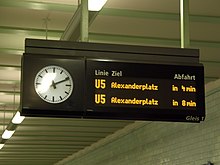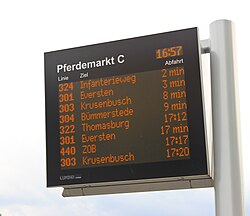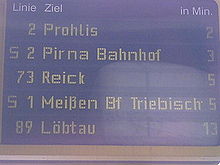Dynamic passenger information
A dynamic passenger information ( DFI , also DyFa ) to passengers teach in public transport over the currently available trips. Static - - set for this data on the long term are timetables from continuously - supplemented determined schedule deviations - dynamic. The passenger information system (DFIS) thus represents an extension of the conventional (static) passenger information .
application

A common demand of passengers to the transport companies is a suitable real time - information . This is to be submitted unsolicited for every deviation from the printed static timetable. In terms of availability, the provider has the obligation to deliver z. B. at construction sites, diversions / replacement traffic, delays and cancellations. A functioning DFI system can present such information at train stations and stops , in vehicles or in information systems (mobile apps, World Wide Web / WAP , SMS , teletext / videotext , telephone inquiries). In this way, a DFI can inform passengers promptly about events.
In individual cases, passengers also have the option of using dynamic passenger information to guide them to their advantage:
- If journeys leave in the same direction from different places (stops, tracks), a DFI can be used for immediate orientation even without knowledge of the timetable, which is why large departure display boards are preferred at large or confusing stops / train stations .
- Occasionally, it makes sense to use other routes or individual means of transport ( walking , taxi, etc.).
Transport companies are increasingly purchasing DFI systems because they increase the acceptance of public transport. In the meantime (as of 2005) such systems are common on privately operated railway lines and in local public transport in larger German cities.
The German Bahn AG received for years of delay information by display systems and loudspeaker announcements. This traveler information system ( RIS ) can be queried via the Internet and information staff in train stations.
Occasionally, road signs pointing to park-and-ride spaces show drivers the minutes until the next public transport leaves the associated stop.
Components of a DFI system

A DFI system generally consists of several components that collect, process and present the information. The first DFI systems were implemented and offered by the manufacturers of such systems as an addition to the existing computer-aided control systems ( RBL ), which, among other things, provide the staff with information on current driving operations. Sophisticated computerized guidance systems have information about the timetable , the route and current vehicle movements, and they have data paths to some of the places where the information is to be presented. Obtaining information from different sources (for example, for information on transferring passengers across all transport companies) and the desired, flexible information display that is possible on modern presentation media requires considerable hardware and software complexity. For this reason, the trend towards seeing a DFI system as an independent functional unit has recently increased (as of 2005). These installations often work closely with control systems. In certain cases, when a highly developed DFI system is installed, which also provides the operating personnel with sufficient information, the need for a control system is no longer given.
The components of a DFI system can be divided into the following functional groups: Operation by the staff, data acquisition, data processing, data transmission, presentation for the passenger.
service
Since various parameters, some of which often have to be changed (for example, canceled trips, special trains , special texts to be displayed) influence the function of the DFI system, it is necessary to provide an operating option for the staff. In addition, such an operator station can inform the staff about the current vehicle positions, the text content of all displays and possible error conditions. In some cases this workstation is combined with the operator workstation of a master computer.
Data acquisition
DFI is based on dynamic real-time information about current vehicle movements. The DFI system receives this information from a master computer (either vehicle positions or pre-processed, forecast arrival and departure times) or from vehicle location systems specially assigned to DFI. Crossing sensors connected with data cables are common for rail vehicles , buses usually have to be localized with radio-supported devices. The vehicles recognize their position, for example, by GPS or by driving past special infrared transmitters and transmit this information using analog or digital private commercial radio or a public network such as GPRS .
In addition to the current vehicle movements, DFI systems also import schedule data (including current changes) automatically from a corresponding computer system in some cases.
Data preparation
This central functionality of the DFI uses a "display strategy" to calculate the information to be presented from the parameters and the recorded dynamic data. This includes the forecast of the future vehicle movement (if this data cannot already be taken over by a control system) and the calculation of the changing texts and graphics for the various presentation media. A complex display strategy must be observed, especially for stationary stop indicators (see below), the information such as "next trip: Line X to Y in Z minutes" (as large as possible and legible from a distance), "the next trips at this stop “(As many journeys as possible are to be displayed), special texts etc. can be displayed alternately in time or in a flexible layout according to a priority control.
Data transfer
The DFI needs an extensive network of data paths to obtain information and to supply the presentation facilities. Different technologies are used here depending on the environment: dedicated electrical and optical cable routes and wide area networks, shared use of standard networks such as large-scale Ethernet installations, ATM and OTN , shared use of the cable or radio data paths of a control system, dedicated radio links, for example based on DECT , public packet-oriented ones Radio networks such as GPRS and UMTS , VPN routes via Internet connections .
presentation
Depending on the system design, the passenger can access the information of the DFI via various media: electronic display boards (displays) in vehicles and stationary at bus stops , automatic or - e.g. B. for the visually impaired - acoustic announcements available at the push of a button in vehicles and stationary at bus stops ( BLIS ), websites on the Internet , automatic telephone announcements , SMS retrieval via mobile phone . Each of these facilities requires appropriately designed hardware , software and data paths.
In the vehicle interior are loudspeaker announcements and character-based LCD displays usual. Fully graphic displays (e.g. TFT monitors and LED or plasma displays) are also used. In some cases, pearl-string displays also provide information about the current position of the vehicle, where either luminous dots mark the next stop on a route map, or small text displays show some of the following stops on the route. At the moment (as of 2008), information about the times at which stopping points are reached and current connection information are not yet common. Sometimes fully graphic displays are also used for advertising purposes. The data supply for the information media in the vehicle interior is usually done by the on-board computer integrated in the control system.
Stationary installations at stops and train stations can consist of optical indicators and acoustic announcement devices. While the acoustic announcements are limited to the announcement of the next trip or - z. E.g. for the visually impaired - read longer texts electronically at the push of a button, train destination displays can permanently present different information.
In addition to the acoustic and optical information used at stops, operable computer terminals can also be provided in the entrance area to query dynamic passenger information.
The display systems are supplied with data via cable ( fieldbus , Ethernet , HDLC ) or radio links ( company radio , DECT, GPRS, DAB ) depending on local conditions .
Presentation of departure times
For the passenger, the most important information from the DFI is the predicted departure time of the vehicle. However, a DFI system can only reliably provide this information if the sensors on the inflow route provide current data on vehicle movements. In the event of disruptions or for sections of the route not equipped with sensors, DFI is forced to use the static times in the timetable. In order to convey this difference to the passenger, many installations show the dynamically forecast arrival or departure time in minutes (e.g. "3 min"), which is particularly useful when the frequency is high, while the static timetable data is given as an absolute time (e.g. B. "13:37"). However, various installations do not offer this service and show all departure times in the same way, so that the reliability of the information cannot be assessed by the passenger. As a compromise, for example at Deutsche Bahn, the static schedule time and, if necessary, the expected delay are displayed (e.g. "13:37 +3").
Cross-company passenger information
Data exchange between local transport companies
In 2003 the Association of German Transport Companies (VDV) defined cross-manufacturer interfaces for cooperation between neighboring transport companies in connection security (VDV 453) and "dynamic timetable information" (VDV 454). Currently (as of 2005) the first DFI systems are being developed that are able to take over dynamic information from neighboring transport companies and present it mixed with their own data. The first systems that work entirely in accordance with VDV 454 now exist, for example at DFI in Vienna or, since 2007, the actual data server (IDS) of the Rhine-Ruhr transport association .
Since 2005, the Stadtwerke München has been combining the dynamic journey information of the underground, suburban train, bus and tram in an information management system (IMS) based purely on VDV 453, from which the passenger information displays are fed. Since 2008, some of this information has also been fed into a web-based timetable information system, which enables stop-related timetable information to be provided in real time for all traffic.
Data exchange between Deutsche Bahn and other local transport companies
Deutsche Bahn cites contractual obstacles to transferring real-time information about the actual journey data of the passenger trains to the systems of other operators. For this reason, only one installation is currently known (as of summer 2005) in which dynamic connection information from S-Bahn trains is displayed on DFI systems of a local transport company. Technically, on the other hand, Deutsche Bahn has ideal conditions for forwarding dynamic transfer information : the UIC data network can reliably deliver real-time data (albeit with regionally different accuracy) via an easily accessible standardized interface.
Conversely, it is not yet customary to provide the disembarking passenger with dynamic information about the local means of transport that can actually be reached directly at the railroad track . In some stations, however, indicators of the local public transport operation are installed in the access area.
photos
Layout drawing announcer
Advance notice with bus and train journeys.
The logo of the bus company and the current time are shown at the top. In between the motto of the transport company in ticker.
The bus trips are displayed with the estimated departure time (in ... min). In the case of train journeys, the scheduled departure time is indicated; in the case of known delays, a corresponding note is added, which is shown alternately with the destination (this is not visible in the static illustration).
As is now customary, all times and train times taken from the timetable are explicitly presented with hours and minutes, while forecast bus departure times are given in the form " in ... minutes ".
Layout drawing train announcement
On the platform, the next five journeys are indicated here with the departure times forecast to the minute.
Layout drawing train destination display
Shortly before a vehicle enters, the display changes to a specific image for this journey with an enlarged, widely visible definition of the journey, “ above locations” and a symbol to indicate the length of the train and the stopping position.
Photo bus announcement
In the underpass, the next 12 departures are indicated here with the departure times forecast to the minute. The departures can also be queried on the WWW and via WAP.
Photo bus departure time display
The next bus departures and their exact departure position on the bus platform are shown on the displays.
Photo dynamic passenger information for buses and trains
In this variant, the departure times for buses and trains are shown on two separate displays.
Photo single line dynamic passenger information
Single-line dynamic passenger information ( dynamic text displays ) is used at smaller Deutsche Bahn AG train stations . These only showed delays in ticker or usually the time (also in ticker). Since a new nationwide update for the DSA, these now always show the next scheduled train.
literature
- Passenger information. In: Barrier-free public transport in Germany , Association of German Transport Companies (ed.), Bramsche, April 2003, ISBN 3-87094-656-3 .
- DIN V ENV 13998 Road traffic telematics , public transport - Stationary non-interactive dynamic passenger information (pre-standard), Beuth-Verlag , Berlin.
See also
- Berlin: Dynamic Directory Assistance and Information System ( BVG )
- Hamburg: Passenger Information and Management System (HHA)
Web links
- VDV453 / VDV454 interfaces ( memento from January 5, 2012 in the Internet Archive ) on vdv.de.
Individual evidence
- ↑ Isabel Klaas, Johannes Bornewasser: Exact forecast for buses and trains. Rheinische Post , April 30, 2013, accessed on May 20, 2013 .









